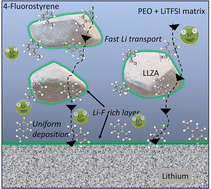Solid-state batteries present a promising avenue that offers improved safety and energy density, effectively addressing the limitations of state-of-the-art lithium-ion batteries. Among different solid electrolytes, composite polymer electrolytes (CPEs) offer versatile multi-component solutions to distinct challenges posed by inorganic solid and organic polymer electrolytes. However, the polymer–filler interface issues significantly hamper their performance when higher ceramic (>20%) loading occurs. Here, we demonstrate an efficient strategy to introduce an in situ-formed fluorine-rich interface for the lithium anode and the ceramic fillers in the CPE. The rationally designed CPE comprises a high ceramic loading of 40% and exhibits significantly high Li-ionic conductivity (10−4 S cm−1 @ 55 °C) and compatibility, along with impressive long cycling performance of the Li|Li symmetric cell for over 2000 cycles at 0.1 mA cm−2. We fabricated all-solid-state Li//LFP full cells that delivered a discharge capacity of 140 mA h g−1 at a 0.1C-rate when cycled at 70 °C and showed good cycling stability. The role of fluorine-containing additives in enhancing conductivity was validated using computations. Furthermore, we extended the applicability of the optimised CPE as an interface modifier in Li//LFP full cells, resulting in improved capacity and long-term cycling.


